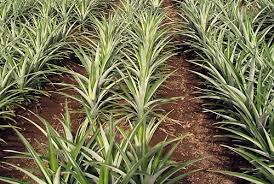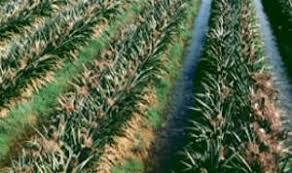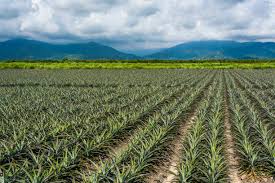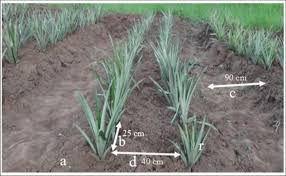Pineapple spacing is an essential factor in successful pineapple cultivation. The way pineapples are spaced directly impacts the growth, fruit quality, and overall yield of the plants. Proper spacing ensures that each pineapple plant receives adequate sunlight, nutrients, and airflow, promoting healthy development and reducing the risk of disease and pest infestations.
If pineapples are spaced too closely, they may compete for resources, leading to stunted growth, smaller fruits, and increased vulnerability to diseases. On the other hand, if they are spaced too far apart, land use may be inefficient, and the farmer may not maximize their potential yield.
In pineapple farming, spacing is primarily determined by the variety of pineapple being cultivated, the soil quality, and the desired farming method (e.g., monoculture or intercropping). Commercial pineapple farmers often use specific planting patterns to optimize land usage and promote efficient harvesting.
The two most common spacing arrangements are the single-row system and the double-row system. Each system has its benefits and challenges, depending on the farm’s size, the farmer’s goals, and local environmental factors.
The single-row system involves planting pineapples in individual rows with adequate spacing between each plant and row. This system allows for easy management and better air circulation, which helps prevent diseases like fungal infections.
In this method, typical spacing between plants within the row ranges from 25 to 30 centimeters (cm), while the distance between rows is generally around 90 to 100 cm. This arrangement allows for easier access during weeding, fertilization, and harvesting.
In contrast, the double-row system involves planting two rows of pineapple plants close to each other, with a wider gap between the next set of double rows. This method is more efficient for maximizing space and is often used in large-scale pineapple production. The distance between plants in a double-row system is usually around 30 cm, with about 60 cm between the two rows in a set.
The gap between each double row set is typically 90 to 100 cm. This arrangement can lead to higher yields per hectare but may require more careful management to avoid overcrowding, which can lead to disease and poor fruit quality.
Apart from these systems, environmental factors such as soil fertility and water availability also play a role in determining the best spacing for pineapples. For example, in areas with low soil fertility, wider spacing may be recommended to allow each plant more access to nutrients.
Conversely, in regions with rich soil and abundant rainfall, tighter spacing may be feasible, as the plants will have access to sufficient resources for optimal growth.
Ultimately, understanding the importance of proper pineapple spacing is key to ensuring a productive and healthy pineapple farm. By considering factors such as variety, soil quality, and local environmental conditions, farmers can optimize spacing to maximize their yield while maintaining the health of their plants.
Importance of Proper Pineapple Spacing

1. Optimized Growth: Proper spacing allows each pineapple plant to have adequate access to sunlight, water, and nutrients from the soil. This supports healthy plant growth and helps the pineapples reach their full size and quality.
2. Disease Prevention: Crowded plants are more likely to develop diseases due to poor air circulation. Proper spacing reduces the risk of fungal infections and other diseases that thrive in humid, closely packed conditions.
3. Efficient Harvesting: With the right spacing, harvesting pineapples becomes easier. Workers can move between rows, reducing damage to the plants and fruits, and making the harvesting process more efficient.
4. Maximized Yield: Proper spacing ensures that each plant has enough room to grow, leading to higher yields per plant. Crowded plants compete for resources, which can result in smaller fruits and reduced overall yields.
Factors Affecting Pineapple Spacing
1. Soil Fertility: In areas with rich, fertile soil, pineapples may grow larger, requiring more space between plants. Poor soil may require closer spacing, but additional fertilization will be necessary.
2. Climate: In regions with high rainfall or humidity, wider spacing may be necessary to prevent fungal growth and ensure good air circulation. In drier climates, spacing can be slightly tighter.
3. Variety of Pineapple: Different pineapple varieties have different growth habits. Larger varieties require more space, while dwarf varieties can be planted closer together.
4. Purpose of Cultivation: Pineapples grown for commercial purposes may need tighter spacing to maximize land use, while those grown for personal use or small-scale farming can be spaced more widely to promote better individual plant growth.
Read Also: 14 Medicinal Health Benefits Of Dalea purpurea (Purple Prairie Clover)
Recommended Spacing for Pineapple Plants

1. Row Spacing: The recommended distance between rows of pineapple plants is usually between 90 cm to 120 cm (3 to 4 feet). This allows enough space for air circulation and easy access during maintenance and harvesting.
2. Plant Spacing Within Rows: Pineapple plants should be spaced about 30 cm to 50 cm (12 to 20 inches) apart within rows. This gives each plant enough room to grow without overcrowding.
3. Double Row Planting: Some growers use a double-row planting system where two rows are spaced closely together, about 60 cm (2 feet) apart, followed by a wider gap of 120 cm (4 feet) before the next double row. This method maximizes land use while still ensuring proper spacing.
Row Spacing Guidelines for Pineapple
1. Standard Row Spacing: The typical distance between rows in pineapple cultivation ranges from 90 cm to 120 cm (3 to 4 feet). This spacing provides enough room for machinery, tools, or workers to move between the rows for maintenance, fertilization, and harvesting without damaging the plants.
2. Double Row Planting: In some systems, a double-row planting pattern is used, where two rows are spaced closely together (about 60 cm apart), followed by a wider gap of 120 cm (4 feet) between the next set of rows. This maximizes land use efficiency without compromising plant health.
3. Row Orientation: Rows should be aligned to maximize exposure to sunlight and encourage air circulation, which helps prevent diseases and promotes even growth across all plants.
Planting Density in Pineapple Cultivation
1. Standard Planting Density: The typical planting density for pineapple ranges from 44,000 to 58,000 plants per hectare, depending on the spacing system. Closer spacing results in higher planting density, which can increase yield per hectare but requires careful management to avoid overcrowding.
2. Impact on Yield: Higher planting densities can result in more fruit per area, but the individual fruit size may be smaller due to competition for nutrients and sunlight. Lower densities may produce fewer fruits per hectare but result in larger and better-quality fruits.
3. Soil and Climate Considerations: In fertile soils or regions with high rainfall, wider spacing is recommended to prevent diseases and overcrowding. In drier or less fertile areas, slightly closer spacing may be used, but additional inputs such as irrigation and fertilizers will be needed.
Pineapple Spacing for Optimal Growth
1. Plant Spacing Within Rows: For optimal growth, plants should be spaced 30 cm to 50 cm (12 to 20 inches) apart within rows. This ensures each plant gets enough light and air, preventing diseases and promoting healthy fruit development.
2. Wider Spacing for Air Circulation: Wider spacing between plants ensures good airflow, which helps reduce the risk of fungal infections. Proper airflow also helps manage humidity levels around the plants, which is important for preventing rot.
3. Balance Between Density and Growth: Finding the right balance between planting density and growth space is key to achieving the best yield. High-density planting maximizes land use, but providing enough room for each plant to grow is essential for high-quality fruit production.
Effects of Overcrowding on Pineapple Plants
1. Reduced Sunlight Exposure: Overcrowded plants compete for sunlight, which can lead to uneven growth. Plants in shaded areas may produce smaller fruits or suffer from stunted growth.
2. Increased Disease Risk: Poor air circulation in overcrowded plantings increases the risk of fungal infections and other diseases. In humid conditions, the lack of space can create an environment where pathogens thrive.
3. Nutrient Competition: When plants are too close together, they compete for nutrients and water in the soil. This competition can result in nutrient deficiencies, poor fruit quality, and reduced overall yield.
4. Smaller Fruit Size: Overcrowded plants often produce smaller fruits, as they cannot access sufficient resources to develop fully. This impacts the commercial value of the harvest and may reduce profitability.
Ensuring proper spacing is crucial for maximizing the growth potential and yield of pineapple plants, while preventing the negative effects of overcrowding.
Read Also: 21 Medicinal Health Benefits of Colchicum autumnale (Autumn crocus)
Pineapple Planting Distance

1. Between Rows: The recommended planting distance between rows of pineapples is around 90 to 120 cm (3 to 4 feet). This allows space for easy movement during maintenance and harvesting and promotes good air circulation.
2. Between Plants Within Rows: The ideal spacing between individual pineapple plants in the same row is about 30 to 50 cm (12 to 20 inches). This distance provides enough room for the plants to grow without overcrowding.
Pineapple Spacing in cm
1. Row Spacing: 90 to 120 cm
2. Plant Spacing: 30 to 50 cm between individual plants in a row
This spacing ensures efficient land use and proper growth conditions for pineapple plants.
Selective Herbicide for Pineapple
For weed control in pineapple farming, selective herbicides are recommended to target unwanted plants without harming the pineapples. Some common selective herbicides for pineapples include:
1. Diuron: A pre-emergent herbicide that controls weeds before they sprout.
2. Bromacil: Often used in pineapple plantations to control broadleaf weeds and grasses.
3. Glyphosate (in controlled doses): Though not fully selective, it is used with care to target weeds around pineapples without affecting the crop.
Always follow local agricultural guidelines and regulations when applying herbicides.
Urea Fertilizer for Pineapple
Urea is a common nitrogen-based fertilizer that can promote healthy growth in pineapples. It is generally applied in small quantities to prevent over-fertilization, which can lead to excessive leaf growth at the expense of fruit development.
Application Recommendations:
1. Apply 200 to 300 kg per hectare during the growth period.
2. Spread the fertilizer around the base of the plants, avoiding direct contact with the stem.
Nitrogen is crucial for foliage development, and urea is an efficient source of this nutrient.
Maturity Period for Pineapple
Pineapples typically take between 18 to 24 months from planting to reach full maturity, depending on the variety and growing conditions. During this period, good management of watering, fertilization, and pest control is essential to produce high-quality fruits.
Flowering usually begins around 12 to 14 months after planting.
Harvest occurs 5 to 6 months after flowering when the fruit has developed fully.
Understanding the maturity period helps ensure that pineapples are harvested at their peak ripeness for the best quality and flavor.
Do you have any questions, suggestions, or contributions? If so, please feel free to use the comment box below to share your thoughts. We also encourage you to kindly share this information with others who might benefit from it. Since we can’t reach everyone at once, we truly appreciate your help in spreading the word. Thank you so much for your support and for sharing!
Read Also: What is Gaseous Fuel?

